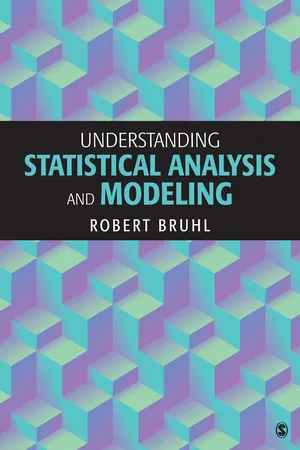
- English
- ePUB (mobile friendly)
- Available on iOS & Android
Understanding Statistical Analysis and Modeling
About this book
Understanding Statistical Analysis and Modeling is a text for graduate and advanced undergraduate students in the social, behavioral, or managerial sciences seeking to understand the logic of statistical analysis. Robert Bruhl covers all the basic methods of descriptive and inferential statistics in an accessible manner by way of asking and answering research questions. Concepts are discussed in the context of a specific research project and the book includes probability theory as the basis for understanding statistical inference. Instructions on using SPSS® are included so that readers focus on interpreting statistical analysis rather than calculations. Tables are used, rather than formulas, to describe the various calculations involved with statistical analysis and the exercises in the book are intended to encourage students to formulate and execute their own empirical investigations.
Frequently asked questions
- Essential is ideal for learners and professionals who enjoy exploring a wide range of subjects. Access the Essential Library with 800,000+ trusted titles and best-sellers across business, personal growth, and the humanities. Includes unlimited reading time and Standard Read Aloud voice.
- Complete: Perfect for advanced learners and researchers needing full, unrestricted access. Unlock 1.4M+ books across hundreds of subjects, including academic and specialized titles. The Complete Plan also includes advanced features like Premium Read Aloud and Research Assistant.
Please note we cannot support devices running on iOS 13 and Android 7 or earlier. Learn more about using the app.
Information
Table of contents
- Cover
- Acknowledgements
- Half Title
- Publisher Note
- Title Page
- Copyright Page
- Brief Contents
- Detailed Contents
- Introduction
- Acknowledgments
- About the Authors
- Part one Research Design
- 1“Why” Conduct Research, and “Why” Use Statistics?
- 2 Methods of Quantitative Empirical Investigation
- Part Two Descriptive Statistics
- 3 The Frequency Distribution Report Organizing a Set of Observations
- 4 The Mode, The Median, and The Mean Describing a Typical Value of a Quantitative Property Observed for a Set of Phenomena
- 5 The Variance and THE Standard Deviation Describing the Variability Observed for a Quantitative Property of a Set of Phenomena
- 6 The z-Transformation and Standardization Using the Standard Deviation to Compare Observations
- Part Three Statistical Inference and Probability
- 7 The Concept of a Probability
- 8 Coexisting Properties and Joint Probability Models
- 9 Sampling and the Normal Probability Model
- Part Four Tools for Making Statistical Inferences
- 10 Estimation Studies Inferring the Parameters of a Population from the Statistics of a Sample
- 11 Chi-Square Analysis Investigating a Suspected Association Between Two Qualitative Properties
- 12 The t−Test of Statistical Significance Comparing a Quantitative Property Assessed for Two Different Groups
- 13 Analysis of Variance Comparing a Quantitative Property Assessed for Several Different Groups
- 14 Correlation Analysis and Linear Regression Assessing the Covariability of Two Quantitative Properties
- Index